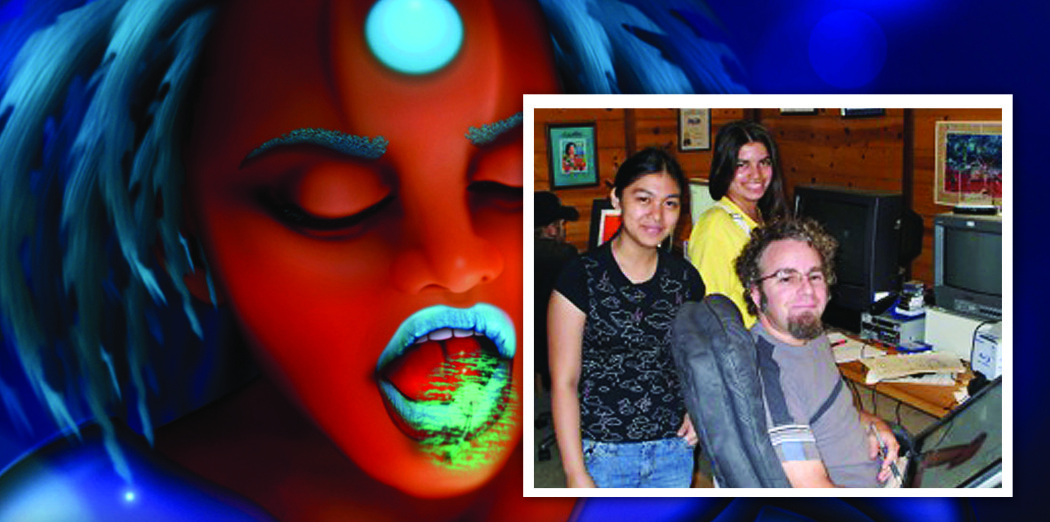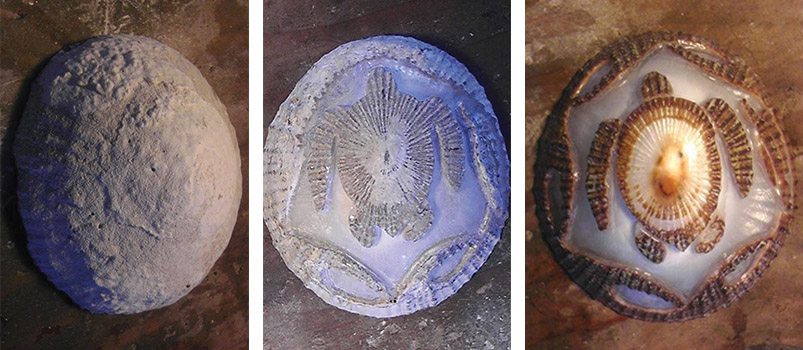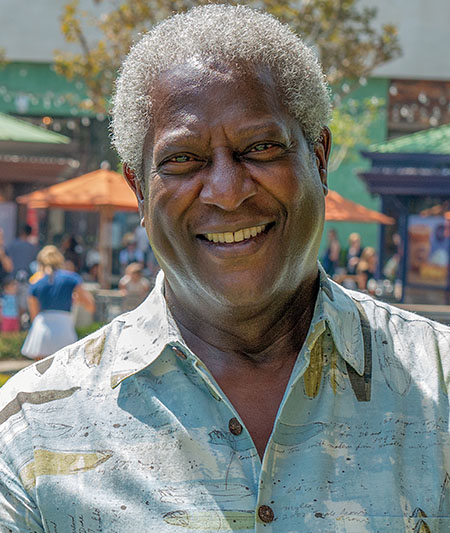
Digital Dream Ready for the Big Screen: Local Animator Involves Hawai‘i Island Youth in Crafting Virtual Realities
 By Paula Thomas
By Paula Thomas
In a modest rural road in Hakalau, on the Hāmākua Coast, sits a rather quaint, non-descript house. It’s an unlikely locale for a high-tech enterprise; but inside its walls is the animation studio of Geoffrey Blair Hajim, known as GB, a digital animator, writer, artist, producer and director.
Hajim is a bundle of energy and creativity packed into a 5-foot, 6-inch frame. When he talks about his new film, “Strange Frame,” his passion bubbles from the wellspring of his love for visual media and what he and co-writer/musician Shelley Doty are trying to put forth.
“Shelley and I are avid sci-fi fans,” he says. “The genre, also called speculative fiction, contains some of the most socially progressive writing that exists. We both felt that to really have a positive effect on culture and to move the discourse forward, we’d need to reach outside “the choir.”
They set about writing a socially progressive, futuristic, popular media story that brings together their combined passions for music, social justice, and great storytelling.
The plot centers on Naia and Parker, both musicians. Naia, an inspired songwriter who is enslaved as a miner, yearns to be a performer. Her dream is realized when she gets tapped for stardom, at the cost of leaving Parker behind. While her success catapults her out of enslavement, stardom turns out to be a different kind of slavery. Parker, concerned for Naia, sets out to free her and redeem their love.
At root, “Strange Frame” is about love and redemption, danger and desire. It’s set in the 28th century on Ganymede, a moon of Jupiter. In this futuristic era, Earth is a poisoned, unlivable planet, and humans, who have become a space-faring species, have to genetically engineer their bodies to adapt to new environments. The exorbitant cost of space travel—the ticket off of toxic Earth—relegates them to lives of perpetual debt slavery that extends to their progeny. Greed, predatory lending, and dishonesty are alive and well on Ganymede.
“We set the movie far into the future where race, sex and gender are no longer issues, much in the way that “Star Trek” gave us the first broadcast of an interracial kiss back in the 1960s,” says Hajim. That gave the writers freedom to explore the struggle to survive in an unbalanced, two-class society from a personal perspective. It’s a cautionary and moving tale. The movie’s title comes from a sentiment of artist Doty: “How fortunate are those who can frame the beauty of the strange.”
The artwork is gorgeous: Original characters are rendered with painstaking detail and delightful, softly sensual color, all of it drawn by Hajim and his small crew of talented employees and interns—all of them based on Hawai‘i Island. While some of the background shots are done via computer-generated imagery (CGI), 90 percent of the scenic work is hand-drawn, giving “Strange Frame” a look and style all its own, with an aesthetic impact tantamount to the uniqueness of films like “Avatar.”
Hajim uses advanced screen tablets as the drawing surfaces, and most of the artwork is made using tools that mimic airbrushing (with masks). Creations are pre-cut into animation-ready elements and then programmed separately, which is called “cut-out style” animation. Because everything has been hand-drawn with a distinctive palette and aesthetic, the work is very different from anything out there. It has the potential to be a breakout style; and one very appealing to young people, futurists, progressives, music lovers, animation fans and gamers, among others.
Says Hajim, “I chose this style because it is unique and it is only done here, in Hawai‘i. It’s also efficient from a production standpoint because it takes a lot less time than some types of computer-rendered imagery.
And that was a tactical decision, given the employment situation on the island. “I wanted to make the style economical so our production costs would not be sky-high. This, I felt, was a prerequisite because we live in one of the most economically challenged areas in the country,” he says.
“I always look at the process and its effects as well as the product. The underlying values of this process—keep it efficient, hire talent for a living wage, develop a sustainable protocol—must be as true as the themes of the product: equality, freedom, opportunity, sustainability. I vowed that with my business I’d find the talent here on the Big Island, nurture it and help provide jobs as well.”
His company name, Island Planet One Productions, was inspired by the words of Hawaiian navigator, Nainoa Thompson, when he said that an island is a microcosm of the planet and spoke of the need to achieve sustainability in smaller ecosystems before you can expect it in larger ones. From that perspective, the island and the planet are one.
To develop a sustainable business, Hajim has worked with career programs through the University of Hawai‘i-Hilo and Hawai‘i Community College, as well as the East Hawai‘i high schools—including the Huiana Internship Program for youth—to build a critical mass of expertise. His indie film has been done on a very small budget—less than $2 million—and has been the training platform for high school and college interns who work alongside some hired staff. Hajim has provided invaluable work experience for more than 40 interns over the past six years.
“Here in East Hawai’i, there aren’t many opportunities for our talented, artistic, and technically-capable kids. Often, they have to choose between staying with their families, whom they love, and resigning themselves to working entry-level jobs or giving up everything they cherish to pursue a career elsewhere, and I don’t think that’s a fair choice.”
His heart is truly in the community and that drives everything he is trying to develop. How he got to Hawai’i is a long story, and it started with his college career. A Connecticut native, Hajim studied at the University of California-San Diego, starting out in astrophysics before switching to visual arts and media science. He explored culture and media with projects like performance art pieces with the Dineh (Navaho) and large mural painting with orphans in Mexico. It was during these years that he became passionate about non-Western art and African filmmaking.
He co-taught a class that compared African films to African literature and, encouraged by a professor, did field work on a topic of his choosing: the kava bowl. “I read everything written about it and wrote papers on it…I spent time in Fiji, Tonga, and Western Samoa. Everyone on my travels opened their homes to me. Everywhere I went I saw communities of people raising each other’s children and taking care of one another. I was in love with the way island people treated each other.”
He went on to graduate work in film production before becoming an islander himself, moving his young family to Hawai‘i to find, in his word, “community.”
Hajim’s love for the island induced him to study its language and immerse himself in Hawaiian culture. Within a short time, he established Screaming Wink Productions to apply his expertise to producing Hawaiian language and culture videos, working with Hau’oli Motta, Luahiwa Namahoe, Kainani Kahunaele and Kala’i Ontai. He produced, among other films, “Pi’apa `Oiwi, The Hawaiian Alphabet”; “Kalanimainu’u—the Story of the Mo’o Goddess of Moloka’i”; and “Ka’ililauokekoa,” which won the Hawai‘i Filmmaker’s Award. These projects enabled him to start honing his cut-out animation style.
Hajim dreams big and is not afraid to take on challenges. Through “Strange Frame” and future projects, he aspires to develop a viable digital animation studio on the island so the talent that is here can stay here, work here, and get known enough to compete for the large-scale projects out of Hollywood. “It can be done,” he insists. “This project [“Strange Frame”] has been a struggle, but I always remember what one of the mothers said, with tears in her eyes, when I gave her daughter an internship:
“When I was her age I could draw as well as her, but there were no opportunities here; so when I graduated, I joined the military, then came back [and] got married, had kids, and never drew again. Thank you for me and my daughter.”
The model for the envisioned studio comes from another giant in the industry, Peter Jackson, the New Zealand-based director whose WETA Studio produced “Lord of the Rings” and most recently, ‘Tintin,” a collaboration with Steven Spielberg.
Like Jackson, Hajim is rooted to place and is committed to building a studio on the island he now calls home. Hawai‘i Island is also an ideal place for his dreams: “Almost any kind of landscape you will need to do films and production is here—desert, rainforest, snow-capped mountains—and it is all within a 50-mile drive,” he says. “It’s more diverse than New Zealand and just perfect for the kind of work I do.”
So many people have fallen in love with “Strange Frame” in its production stage that it has attracted an A-list of performers for the voices, including Tim Curry (“Rocky Horror Picture Show,” “Ferngully”), Claudia Black (“Stargate SG1,” “Farscape”), George Takei (“Star Trek, “Heroes”), Michael Dorn (“Star Trek,” “Transformers”), Ron Glass (“Barney Miller,” “Firefly,” “Serenity”), Alan Tudyk (“Firefly,” “Serenity,” “Transformers”), Juliet Landau (“Buffy the Vampire Slayer,” “Ed Wood”), and Claudia Christian (“Babylon5”).
Roger Waters (of Pink Floyd) offered “Strange Frame” a Pink Floyd song to complement the innovative style and content in the movie that caught his attention.
Academy Award-winner Gary Rizzo (“Inception,” “Titanic,” “Star Wars,” “Dark Knight,” and “The Incredibles”) agreed to do the sound mix at Skywalker Ranch.
“Strange Frame” already has more than 20,000 Facebook fans from more than 20 countries.
Big dreams come with big challenges. Now, “Strange Frame” is almost finished but needs an infusion of capital for the writing of some additional scenes before it goes to market. While fundraising is hard-going right now, “Strange Frame” promises to be a breakthrough film that, according to some, is just what is needed to start an industry on Hawai‘i Island. Beyond this film, three sequels, several TV pilots and other projects are in the planning stages.
And it’s all happening in a sweet little house in Hakalau. ❖
Island Planet One Productions: 808.963.5482, www.strangeframe.com
To contact the writer: paula@delphipacific.com


